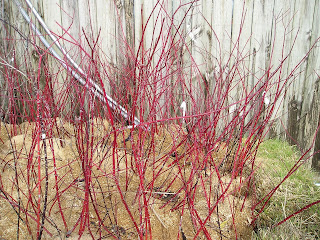First though what are hardwood cuttings? Hardwood cuttings are taken from branches that have had some time to develop a brown outer coating on the bark. The branches have gone dormant and have dropped their leaves which allows them to focus all their energy on root development. With hardwood cuttings you don't have to worry about leaf desiccation (a fancy word for - dying leaves caused by lack of moisture). What you do have to worry about is excessive moisture around the cuttings. Winters are typically more wet than the rest of the year so it is important to have well drained soil present around your hardwood cuttings.
So let's get started with the plants!
5 Shrubs to Propagate in Late Fall or Winter through Hardwood Cuttings
1. Viburnums! Viburnums are one of my most favorite shrubs. Some are fragrant, some produce loads of berries for the birds, some are edible (Cranberry viburnum), some are evergreen while others are deciduous, but all are beautiful! A 6 to 8 inch cutting is adequate for getting a viburnum to root with a hardwood cutting.
2. Forsythia. Forsythias are one of the first shrubs to bloom in spring. I see them in the nurseries for $20-$30 for rather small shrubs. The thing is you can make a ton of these shrubs very fast just by sticking hardwood cuttings in the soil. The only reason for their expensiveness is their popularity. I highly recommend looking for the 'Kumson' forsythia. It's a variegated form from Asia that often reblooms in the fall.
3. Red twig dogwoods. Everyone likes dogwoods. Most people think of the dogwood trees that flower in the spring, but in the fall and winter the dogwoods with the colorful stems take the stage! Red twig dogwoods root extremely easy from hardwood cuttings. They are a perfect plant to place in front of evergreens for some winter contrast.
4. Willows! OK, willows are easy to root nearly anytime but fall and winter are a great times to root them with minimal effort. Have you ever wanted to grow a willow fence? Or a willow hedge? Or any other willow structure? You can get rather long pieces of willow to root for these purposes. I've rooted many of my dappled willows in the winter just by sticking the cutting in the ground.
5. Beautyberry. If you don't have a beautyberry you absolutely need to get one. Callicarpa americana is the native one but there are others form Asia like Callicarpa japonica or Callicarpa dichotoma. Most beautyberries have purple berries that are stunning in the fall but there are even some varieties with white berries or variegated leaves!
How to Take Hardwood Cuttings
To take hardwood cuttings select first year growth that has hardened off. I usually wait until after leaf drop but if there are a couple leaves still left you can remove them and use the cutting anyway. I try to take cuttings about 6-8 inches long with several nodes along the stem. You can take shorter cuttings of beautyberry - perhaps around 4 inches. Use well drained soil or medium for hardwood cuttings. They need to stay moist but not waterlogged. Sand beds are often used. Simply make a raised bed with chicken wire underneath to prevent rodents from burrowing inside. Then fill it with sand. You can cover with plastic to help retain the moisture. If you are in the shade you don't need to do much more than that but you may wish to paint the plastic with a light layer of white spray paint to prevent the sunlight from becoming too intense which will otherwise bake your plant material on sunny days. Another method is to use pots and put them inside of plastic grocery store bags with the top gently tied off. Keep them in a shady area until spring. You will need to check your cuttings every week or so to make sure they stay moist!
None of these shrubs need rooting hormone but it can be an aid. I never use rooting hormones on willows since it would really just be wasted. They are just too easy to root!
Are you planning on trying any hardwood cuttings this year?



